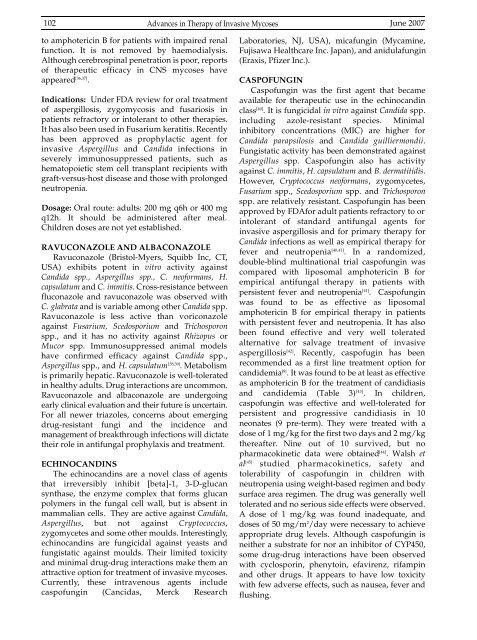Vol 39 # 2 June 2007 - Kma.org.kw
Vol 39 # 2 June 2007 - Kma.org.kw
Vol 39 # 2 June 2007 - Kma.org.kw
- No tags were found...
You also want an ePaper? Increase the reach of your titles
YUMPU automatically turns print PDFs into web optimized ePapers that Google loves.
102Advances in Therapy of Invasive Mycoses <strong>June</strong> <strong>2007</strong>to amphotericin B for patients with impaired renalfunction. It is not removed by haemodialysis.Although cerebrospinal penetration is poor, reportsof therapeutic efficacy in CNS mycoses haveappeared [36,37] .Indications: Under FDA review for oral treatmentof aspergillosis, zygomycosis and fusariosis inpatients refractory or intolerant to other therapies.It has also been used in Fusarium keratitis. Recentlyhas been approved as prophylactic agent forinvasive A s p e rg i l l u s and C a n d i d a infections ins e v e rely immunosuppressed patients, such ashematopoietic stem cell transplant recipients withgraft-versus-host disease and those with prolongedneutropenia.Dosage: Oral route: adults: 200 mg q6h or 400 mgq12h. It should be administered after meal.Children doses are not yet established.RAVUCONAZOLE AND ALBACONAZOLERavuconazole (Bristol-Myers, Squibb Inc, CT,USA) exhibits potent in v i t ro activity againstCandida spp., Aspergillus spp., C. neoformans, H.capsulatum and C. immitis. Cross-resistance betweenfluconazole and ravuconazole was observed withC. glabrata and is variable among other Candida spp.Ravuconazole is less active than voriconazoleagainst Fusarium, Scedosporium and Tr i c h o s p o ro nspp., and it has no activity against Rhizopus orM u c o r spp. Immunosuppressed animal modelshave confirmed efficacy against C a n d i d a s p p . ,Aspergillus spp., and H. capsulatum [38,<strong>39</strong>] . Metabolismis primarily hepatic. Ravuconazole is well-toleratedin healthy adults. Drug interactions are uncommon.Ravuconazole and albaconazole are undergoingearly clinical evaluation and their future is uncertain.For all newer triazoles, concerns about emergingd ru g - resistant fungi and the incidence andm a n a g e m e n tof breakthrough infections will dictatetheir role in antifungal prophylaxis and treatment.ECHINOCANDINSThe echinocandins are a novel class of agentsthat irreversibly inhibit [beta]-1, 3-D-glucansynthase, the enzyme complex that forms glucanpolymers in the fungal cell wall, but is absent inmammalian cells. They are active against Candida,A s p e rg i l l u s, but not against C r y p t o c o c c u s,zygomycetes and some other moulds. Interestingly,echinocandins are fungicidal against yeasts andfungistatic against moulds. Their limited toxicityand minimal drug-drug interactions make them anattractive option for treatment of invasive mycoses.C u r re n t l y, these intravenous agents includecaspofungin (Cancidas, Merck Researc hLaboratories, NJ, USA), micafungin (Mycamine,Fujisawa Healthcare Inc. Japan), and anidulafungin(Eraxis, Pfizer Inc.).CASPOFUNGINCaspofungin was the first agent that becameavailable for therapeutic use in the echinocandinclass [40] . It is fungicidal in vitro against Candida spp.including azole-resistant species. Minimalinhibitory concentrations (MIC) are higher forCandida parapsilosis and C a n d i d a g u i l l i e r m o n d i i.Fungistatic activity has been demonstrated againstA s p e rg i l l u s spp. Caspofungin also has activityagainst C. immitis, H. capsulatum and B. dermatitidis.H o w e v e r, Cryptococcus neoformans, zygomycetes,Fusarium spp., Scedosporium spp. and Trichosporonspp. are relatively resistant. Caspofungin has beenapproved by FDAfor adult patients refractory to orintolerant of standard antifungal agents forinvasive aspergillosis and for primary therapy forCandida infections as well as empirical therapy forfever and neutro p e n i a [ 40 , 41 ] . In a randomized,double-blind multinational trial caspofungin wasc o m p a red with liposomal amphotericin B forempirical antifungal therapy in patients withpersistent fever and neutropenia [41] . Caspofunginwas found to be as effective as liposomalamphotericin B for empirical therapy in patientswith persistent fever and neutropenia. It has alsobeen found effective and very well toleratedalternative for salvage treatment of invasivea s p e rg i l l o s i s [ 42 ] . Recently, caspofugin has beenrecommended as a first line treatment option forcandidemia [8] . It was found to be at least as effectiveas amphotericin B for the treatment of candidiasisand candidemia (Table 3) [ 43 ] . In childre n ,caspofungin was effective and well-tolerated forpersistent and pro g ressive candidiasis in 10neonates (9 pre-term). They were treated with adose of 1 mg/kg for the first two days and 2 mg/kgt h e re a f t e r. Nine out of 10 survived, but nopharmacokinetic data were obtained [44] . Walsh eta l [ 45 ] studied pharmacokinetics, safety andtolerability of caspofungin in children withneutropenia using weight-based regimen and bodysurface area regimen. The drug was generally welltolerated and no serious side effects were observed.A dose of 1 mg/kg was found inadequate, anddoses of 50 mg/m 2 /day were necessary to achieveappropriate drug levels. Although caspofungin isneither a substrate for nor an inhibitor of CYP450,some drug-drug interactions have been observedwith cyclosporin, phenytoin, efavirenz, rifampinand other drugs. It appears to have low toxicitywith few adverse effects, such as nausea, fever andflushing.
















